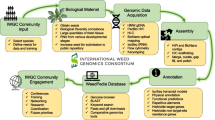Abstract
Seed orchards should produce seeds that are both abundant and of high genetic value. This study suggests methods to achieve such a compromise and study their efficiency. The methods were applied on data obtained from 41 seed orchard clones of Scots pine from mid-Sweden. The value of the seed orchard crop was set as a function of its breeding value, the amount of seeds produced and their gene diversity, measured as the effective number of clones. The proportion of ramets of different clones that maximized this value was regarded as the optimum for deployment of the clones in a seed orchard. The results were compared with truncation selection for breeding value, truncation selection for clone benefit (the product of seed production and breeding value) and linear deployment (where ramets are deployed linearly in relation to breeding value). The influence of two parameters was studied: the relative importance of breeding value for seed value and the size of the penalty for reducing the value of the seed crop with respect to lost gene diversity. The conventional wisdom is to select the clones with the highest breeding values, but that turned out to be the most inferior alternative studied. Clone benefit truncation provided a good approximation to optimal benefit for cases, where the effective number was low and dependence of breeding value limited.
Similar content being viewed by others
References
Almqvist C., Eriksson U. and Yazdani R. 1995. Arbetsrapport. Nr. 307. The Forestry Research Institute of Sweden (Skogforsk).
Almqvist C., Jansson G. and Sonesson J. 2001. Genotypic correlations between early cone-set and height growth in Picea abies clonal trials. Forest Genet. 8: 197–204.
Bila A.D., Lindgren D. and Mullin T.J. 1999. Fertility variation and its effect on diversity over generations in a teak plantation (Tectona grandis L.f.). Silvae Genet. 48(3–4): 109–114.
Hu J. 1999. Roguing in a clonal seed orchard of masson pine. J. Jiangsu Forest Sci. Technol. 26(3): 29–31 (in Chinese with English summary).
Jonsson A., Ekberg I. and Eriksson G. 1976. Flowering in a seed orchard of Pinus sylvestris L. Stud. For. Succ. 165: 38.
Kang K.S. 2001. Genetic gain and gene diversity of seed orchard crops. Ph.D. thesis.Swedish University of Agricultural Sciences, Umea, Sweden.Acta Universitatis Agriculturae Sueciae, Silvestria 187, 75 pp.
Kang K.S., Bila A.D., Harju A.M. and Lindgren D. 2003. Fertility variation in forest tree populations. Forestry (in press).
Kjaer E.D. 1996. Estimation of effective population number in a Picea abies (Karst) seed orchard based on flower assessment. Scand. J. Forest Res. 11: 111–121.
Lindgren D. and Matheson A.C. 1986. An algorithm for increasing the genetic quality of seed from seed orchards by using the better clones in higher proportions. Silvae Genet. 35(5–6): 173–177.
Lindgren D. and Mullin T.J. 1998. Relatedness and status number in seed orchard crops. Can. J. Forest Res. 28: 276–283.
Nikkanen T. and Velling P. 1987. Correlations between flowering and some vegetative characteristics of grafts of Pinus sylvestris. Forest Ecol. Manag. 19: 35–40.
Olsson T., Lindgren D. and Li B. 2001. Balancing genetic gain and relatedness in seed orchards. Silvae Genet. 50: 222–227.
Rosvall O. and Eriksson B. 2002. Nya fröplantager i Sverige — underlag för strategiska beslut. SkogForsk Arbetsrapport 499.
Son S.-G., Kang K.-S., Lindgren D. and Hyun J.-O. 2003. Qualification for the value of seed orchard considering breeding value and seed productivity. J. Korean Forest Assoc. 91: 601–608.
Sonesson J. 1995. Avelsvärden. Nr. 20. The Forestry Research Institute of Sweden (Skogforsk).
Sonesson J. and Hannerz M. 1999. Förädlade plantor är lönsamma för familjeskogsbruket. SkogForsk, Resultat 21, 4 p.
Sorensen F.C. and Webber J.E. 1997. On the relationship between pollen capture and seed set in conifers. Can. J. Forest Res. 27: 63–68.
Yanchuk A.D. 1996. General and specific combining ability from disconnected partial diallels of coastal Douglas-fir. Silvae Genet. 45: 37–45.
Author information
Authors and Affiliations
Corresponding author
Rights and permissions
About this article
Cite this article
Lindgren, D., Cui, J., Son, S.G. et al. Balancing seed yield and breeding value in clonal seed orchards. New Forests 28, 11–22 (2004). https://doi.org/10.1023/B:NEFO.0000031327.30521.ca
Issue Date:
DOI: https://doi.org/10.1023/B:NEFO.0000031327.30521.ca



